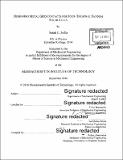Designing metal grid contacts for four-terminal tandem solar cells
Author(s)
Sofia, Sarah E. (Sarah Elizabeth)
DownloadFull printable version (8.210Mb)
Alternative title
Designing metal grid contacts for 4-terminal tandem solar cells
Designing metal grid contacts for 4T tandem solar cells
Other Contributors
Massachusetts Institute of Technology. Department of Mechanical Engineering.
Advisor
Tonio Buonassisi and Ian Marius Peters.
Terms of use
Metadata
Show full item recordAbstract
Flat-panel tandem solar cells have demonstrated the potential to exceed the efficiencies of their single-junction constituents. However, robust rules for tandem solar cell design are currently lacking, slowing the development of cost-effective implementations of this technology. The four-terminal (4T) architecture stacks electrically independent sub-cells and avoids current-matching losses, resulting in two main advantages over the conventional integrated two-terminal (2T) architecture: a higher energy yield and a loosened constraint on material bandgap combinations. Because both sub-cells are contacted independently in a 4T tandem, multiple stacked semi-transparent contacts are needed, causing significant shading and series resistance losses. Moreover, for stationary flat panel tandems that do not use tracking, contacts need to be optimized for a varying direction of incident sunlight. In this study, we develop a framework for optimizing metal grid contacts for 4T tandem solar cells and quantify the electrical and optical loss associated with these contacts. We also examine the question of under which circumstances it is beneficial to align metal grid contact fingers to reduce shading. We find that, for most applications, the front and back contacts of the top cell should be aligned, resulting in an increase in energy yield by 1 - 2 %. We also find that aligning the contacts of top and bottom cells is not beneficial and may even result in a reduced energy yield. This additionally highlights the importance of using energy yield, rather than standard test condition efficiency, as a figure of merit when considering device design.
Description
Thesis: S.M., Massachusetts Institute of Technology, Department of Mechanical Engineering, 2016. Cataloged from PDF version of thesis. Includes bibliographical references (pages 52-55).
Date issued
2016Department
Massachusetts Institute of Technology. Department of Mechanical EngineeringPublisher
Massachusetts Institute of Technology
Keywords
Mechanical Engineering.